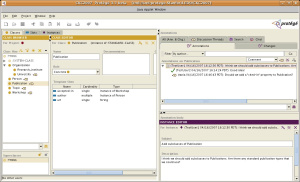Difference between revisions of "Collaborative Protege"
(added mpl info) |
|||
| Line 1: | Line 1: | ||
{{Plugin | {{Plugin | ||
| − | | | + | |Description=Collaborative Protégé is an extension of the existing Protégé system that supports collaborative ontology editing. In addition to the common ontology editing operations, it enables annotation of both ontology components and ontology changes. It supports the searching and filtering of user annotations based on different criteria. We have implemented two types of voting mechanisms that can be used for voting of change proposals. Multiple users may edit the same ontology at the same time. In multi-user mode, all changes made by one user are seen immediately by other users. |
|ForApplication1=Protege-Frames | |ForApplication1=Protege-Frames | ||
|ForApplication2=Protege-OWL | |ForApplication2=Protege-OWL | ||
| Line 12: | Line 12: | ||
|Affiliation1=Stanford Medical Informatics | |Affiliation1=Stanford Medical Informatics | ||
|Affiliation2=Stanford University | |Affiliation2=Stanford University | ||
| − | |||
}} | }} | ||
| − | |||
<div style="display:block; float:left; width:100%;"> | <div style="display:block; float:left; width:100%;"> | ||
== More Details == | == More Details == | ||
| + | |||
| + | There are two working modes available for Collaborative Protégé. Both modes support multiple users working on an ontology: | ||
| + | |||
| + | * The multi-user mode - allows mutiple clients to edit simultaneously the same ontology hosted on a Protégé server. All changes made by one client are immediately visible by other clients. This mode is also referred to as client-server mode, or concurrent mode and requires a client-server setup. This mode is based on the implementation of the multi-user Protégé and is the preferred mode in which Collaborative Protégé should be run. | ||
| + | * The standalone mode - allows multiple users to access the same ontology in succession. The ontology can be stored on a shared netword drive and all clients will access the same project files. However, simultaneous access is not possible. This mode is also referred to as the consecutive mode. | ||
| + | |||
| + | This user guide applies to both multi-user and standalone mode of Collaborative Protégé. | ||
| + | |||
Collaborative Protege is documented on the main Protege Website: http://protege.stanford.edu/doc/collab-protege/.<br /><br /> | Collaborative Protege is documented on the main Protege Website: http://protege.stanford.edu/doc/collab-protege/.<br /><br /> | ||
</div> | </div> | ||
Revision as of 14:33, October 20, 2008
Collaborative Protege
Collaborative Protégé is an extension of the existing Protégé system that supports collaborative ontology editing. In addition to the common ontology editing operations, it enables annotation of both ontology components and ontology changes. It supports the searching and filtering of user annotations based on different criteria. We have implemented two types of voting mechanisms that can be used for voting of change proposals. Multiple users may edit the same ontology at the same time. In multi-user mode, all changes made by one user are seen immediately by other users.
Versions & Compatibility
This section lists available versions of Collaborative Protege.
No version information available.
If you click on the button below to add a new version of Collaborative Protege, you will be asked to define a page title for the new version. Please adhere to the naming convention of Collaborative Protege X.X.X when you define the new page!
Changelog
No version information available.
More Details
There are two working modes available for Collaborative Protégé. Both modes support multiple users working on an ontology:
* The multi-user mode - allows mutiple clients to edit simultaneously the same ontology hosted on a Protégé server. All changes made by one client are immediately visible by other clients. This mode is also referred to as client-server mode, or concurrent mode and requires a client-server setup. This mode is based on the implementation of the multi-user Protégé and is the preferred mode in which Collaborative Protégé should be run. * The standalone mode - allows multiple users to access the same ontology in succession. The ontology can be stored on a shared netword drive and all clients will access the same project files. However, simultaneous access is not possible. This mode is also referred to as the consecutive mode.
This user guide applies to both multi-user and standalone mode of Collaborative Protégé.
Collaborative Protege is documented on the main Protege Website: http://protege.stanford.edu/doc/collab-protege/.
